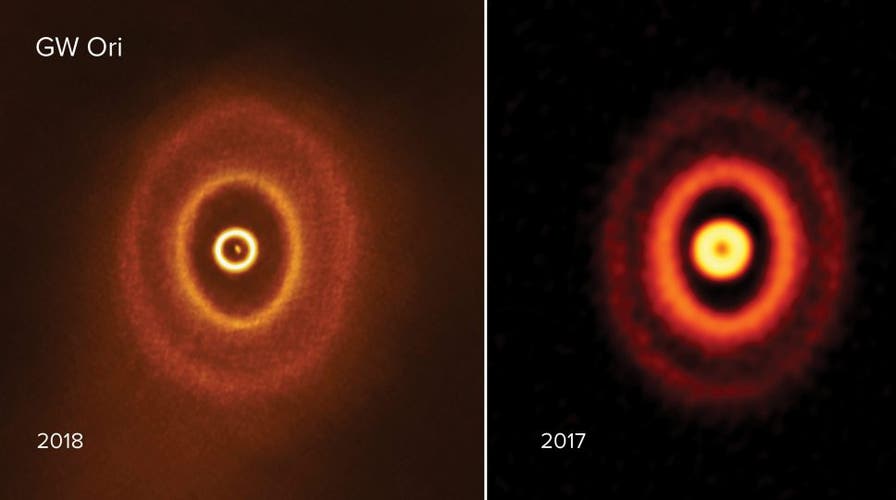Fox News Flash top headlines for September 5
Fox News Flash top headlines are here. Check out what's clicking on Foxnews.com.
Researchers have discovered a three-star solar system that could also be home to a planet in deep space, according to a new study.
The research, published in Science, notes the GW Orionis star system, which is located at the edge of the Orion constellation 1,300 light-years from Earth, has two stars (GW Ori A and B) that orbit one another and the third (GW Ori C) orbits the two siblings at a distance of approximately 8 au, or approximately 740 million miles. Inside the rings could be dust, or the beginnings of a young exoplanet, which could explain the misalignment of the system's gravitational pull.
“The inner ring contains enough dust to build 30 Earths, which is sufficient for a planet to form in the ring," the study's lead author, Stefan Kraus from the University of Exeter, said in a statement.

GW Orionis Credit: ALMA (ESO/NAOJ/NRAO), S. Kraus & J. Bi; NRAO/AUI/NSF, S. Dagnello
NASA FINDS ACTIVE 'STAR WARS' GALAXY IN DEEP SPACE
A separate group of researchers, which also wrote about the star system in The Astrophysical Journal Letters in May, noted that the misalignment could also be caused by a planet.
“Our simulations show that the gravitational pull from the triple stars alone cannot explain the observed large misalignment," said the second study's co-author, Nienke van der Marel, in the same statement.
“We were surprised to see the strong misalignment of the inner ring,” said Jiaqing Bi, lead author of a separate study on the topic published earlier this year, in the same statement. “But the strange warp in the disk is confirmed by a twisted pattern that ALMA measured in the gas of the disk.”
MILKY WAY GALAXY COULD HAVE 'OCEAN WORLDS' ALL OVER, NASA SAYS
Both sets of researchers used the Atacama Large Millimeter/submillimeter Array (ALMA) in Chile to come up with their findings.
Three-star systems are rare in the universe, but not unprecedented. In 2019, scientists from the Harvard Center for Astrophysics used NASA's Transiting Exoplanet Satellite Survey telescope to discover planet LTT 1445 A b and its three stars, 22 light-years from Earth.
The researchers used the telescope arrays to look at the orbit of the three stars for 11 years, discovering they are all on different planes and misaligned. “This proved crucial to understand how the stars shape the disk,” study co-author John Monnier added.
Further research is needed to confirm whether a potential planet exists, though the evidence is pointing in favor of its presence, van der Marel explained.
"We think that the presence of a planet between these rings is needed to explain why the disk was torn apart," she said. This planet has likely carved a dust gap and broken the disk at the location of the current inner and outer rings.”
MULTIPLE EXOPLANETS ORBITING 'SUN-LIKE STAR' DISCOVERED IN DEEP SPACE FOR THE FIRST TIME
In June 2016, exoplanet Kepler-1647 b was discovered 3,700 light-years from Earth. It is part of a double-star system, similar to Luke Skywalker's planet, Tatooine.
More than 4,000 exoplanets have been discovered by NASA in total, approximately 50 of which were believed to potentially be habitable as of September 2018. They have the right size and the right orbit of their star to support surface water and, at least theoretically, to support life.
CLICK HERE TO GET THE FOX NEWS APP
Fox News' James Rogers contributed to this story.

